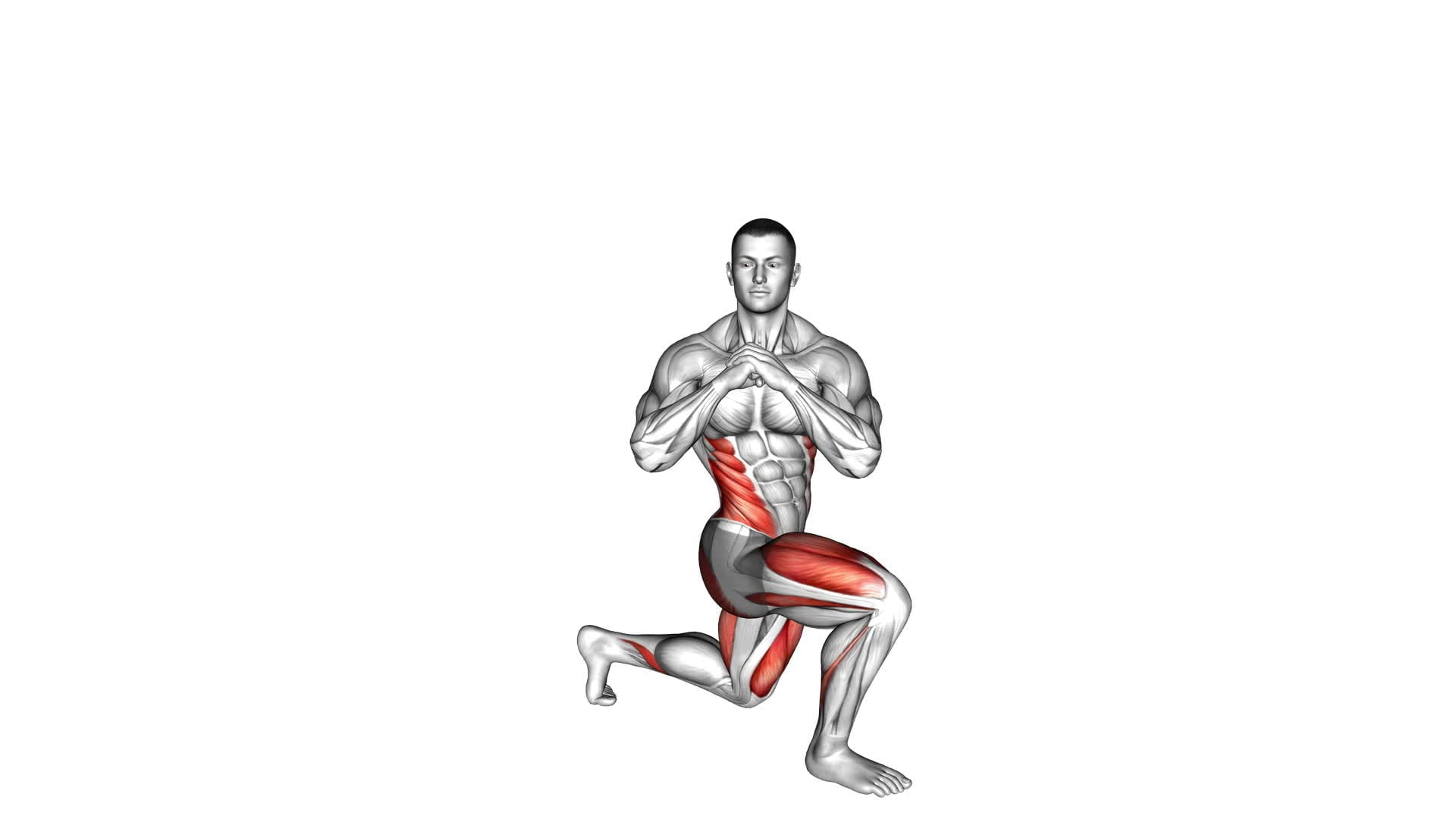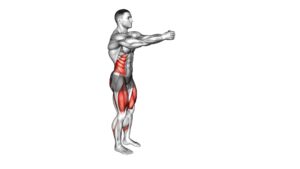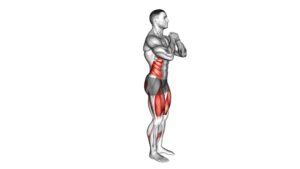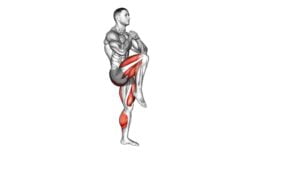Lunge With Twist – Video Exercise Guide & Tips

Looking to level up your workout routine? Check out our video exercise guide and tips for the lunge with twist. This dynamic move targets multiple muscle groups and improves core strength.
Watch This Exercise Video
In this guide, we'll show you the proper form and technique, common mistakes to avoid, and modifications for all fitness levels. Plus, we'll share valuable tips to help you get the most out of your workout.
So grab your mat and let's get lunging!
Key Takeaways
- The lunge with twist targets multiple muscle groups and improves core strength.
- Proper form and technique include standing tall, stepping forward into a lunge position, and rotating the torso from the waist.
- Common mistakes to avoid include not maintaining a stable core and rushing through the exercise.
- Advanced variations of the lunge with twist include adding dumbbells or resistance bands and incorporating plyometric movements.
Benefits of the Lunge With Twist
You can maximize your workout by incorporating the lunge with twist, which offers a range of benefits for your body. This exercise not only targets your lower body muscles but also engages your core and improves your balance. By adding a twist to the lunge, you activate your oblique muscles, which are essential for stability and rotation.
One of the key benefits of the lunge with twist is the improvement of core strength. As you twist your torso during the exercise, your abdominal muscles work to stabilize and rotate your body. This helps to strengthen your core, which is vital for maintaining proper posture and preventing lower back pain.
Additionally, the lunge with twist helps to increase flexibility in your hips and lower back. The twisting motion stretches these areas, improving their range of motion and reducing muscle tightness.
Incorporating the lunge with twist into your workout routine can have a significant impact on your overall fitness. Not only will it strengthen your core and increase flexibility, but it will also tone your leg muscles and improve your balance. Start by mastering the proper form and gradually increase the difficulty by adding weights or using a stability ball.
Remember to always listen to your body and consult a professional trainer if you have any concerns or questions.
Proper Form and Technique
To ensure proper form and technique for the lunge with twist, focus on maintaining a stable and balanced position throughout the exercise. Here are some key points to keep in mind:
- Align your body: Stand tall with your feet hip-width apart. Step forward with one foot into a lunge position, making sure your knee is directly above your ankle and your back knee is hovering just above the ground.
- Engage your core: Activate your abdominal muscles by drawing your belly button in towards your spine. This will help stabilize your body and protect your lower back.
- Twist from the waist: As you lunge forward, rotate your torso towards the side of your front leg. Keep your arms extended in front of you and twist from your waist, not your shoulders.
- Injury prevention: Avoid excessive twisting or leaning forward, as this can strain your back and increase the risk of injury. Focus on controlled movements and maintain proper alignment throughout the exercise.
- Muscle activation: The lunge with twist primarily targets your quadriceps, glutes, hamstrings, and core muscles. By engaging these muscles properly, you can enhance muscle activation and maximize the benefits of the exercise.
By following these guidelines, you can perform the lunge with twist safely and effectively, reducing the risk of injury and ensuring optimal muscle activation.
Remember to listen to your body and modify the exercise as needed to suit your fitness level and capabilities.
Common Mistakes to Avoid
Maintaining proper form and technique is crucial in order to avoid common mistakes while performing the lunge with twist exercise. By being aware of these mistakes to avoid, you can ensure that you're getting the most out of this exercise and minimizing the risk of injury.
One common error to watch out for isn't maintaining a stable core. This exercise requires stability in your abdominal muscles to execute the twist effectively. Therefore, it's important to engage your core throughout the movement to prevent any excessive twisting or strain on your lower back.
Another mistake to avoid isn't stepping far enough into the lunge position. Failing to step far enough can lead to an improper alignment of your knees and can put unnecessary pressure on your joints. Additionally, make sure to keep your front knee aligned with your ankle and avoid letting it collapse inward.
Lastly, rushing through the exercise is a common error. Take your time and focus on the proper form and technique to ensure maximum effectiveness.
Modifications for All Fitness Levels
For modifications suitable for all fitness levels, consider incorporating variations of the lunge with twist exercise. This exercise can be adapted to meet the needs of beginners and advanced individuals, as well as those recovering from injuries.
Here are some exercise variations to try:
- Exercise Variations for Beginners:
- Start with a stationary lunge with twist, keeping your back foot planted and focusing on the twisting motion.
- Use lighter weights or no weights at all to reduce resistance and allow for better form and control.
- Decrease the range of motion by taking smaller steps during the lunge or by not going as deep into the lunge position.
- Exercise Variations for Advanced Levels:
- Add dumbbells or resistance bands to increase the challenge and strengthen your muscles further.
- Incorporate plyometric movements, such as jump lunges with twist, to improve power and explosiveness.
- Increase the range of motion by taking longer lunges or by adding a deeper twist at the end of each lunge.
- Adapting the Lunge with Twist for Injury Rehabilitation:
- Perform the exercise with a shorter range of motion to avoid putting excessive strain on the injured area.
- Use a modified lunge, such as a reverse lunge with twist, to reduce stress on the knees or ankles.
- Start with lighter weights or no weights at all and gradually increase the resistance as you progress in your recovery.
By incorporating these modifications, you can tailor the lunge with twist exercise to your fitness level and address any specific injury concerns.
Now, let's move on to the next section where we'll provide tips for getting the most out of your workout.
Tips for Getting the Most Out of Your Workout
To maximize your workout, make sure you're incorporating proper form and focusing on engaging the targeted muscles throughout the lunge with twist exercise. This exercise can be a great addition to your routine, but it's important to take some additional steps to get the most out of your workout.
Before starting your workout, it's crucial to do a proper pre-workout warm-up. This helps to prepare your muscles for the upcoming activity and can help reduce the risk of injury. A warm-up can include activities like light cardio, dynamic stretching, and mobility exercises. Spend a few minutes warming up your body before diving into the lunge with twist exercise.
After your workout, it's essential to prioritize post-workout recovery. This allows your body to repair and rebuild, helping you to get stronger and prevent muscle soreness. Make sure to cool down properly by doing some light stretching and foam rolling. Additionally, it's important to refuel your body with a combination of protein and carbohydrates to replenish your energy stores and aid in muscle recovery.
Frequently Asked Questions
How Many Sets and Repetitions Should I Do for the Lunge With Twist Exercise?
To determine the number of sets and repetitions for the lunge with twist exercise, consider your fitness level and goals.
Start with 2-3 sets of 10-12 repetitions per leg.
Gradually increase the intensity by adding weights to enhance muscle strength and endurance.
Beginners can modify the exercise by performing lunges without weights or reducing the range of motion.
Adding weights can provide additional resistance and target the muscles more effectively.
Can the Lunge With Twist Exercise Help Improve Balance and Stability?
Improving balance and stability is a common goal for many people. One exercise that can help you achieve this is the lunge with twist.
By incorporating a twisting motion into the lunge, you engage your core and challenge your balance. This exercise helps to strengthen the muscles in your legs, hips, and core, which are essential for maintaining stability and preventing falls.
Regularly performing the lunge with twist can lead to improved balance and stability over time.
Is It Safe to Perform the Lunge With Twist Exercise if I Have Knee or Hip Issues?
If you have knee or hip issues, it's important to be cautious when performing the lunge with twist exercise. Before attempting it, consult with a healthcare professional or a certified trainer to determine if it's safe for you.
There are modifications available to make the exercise more suitable for individuals with knee or hip issues.
Lunges, in general, can improve balance and stability when performed correctly and with proper form.
Will the Lunge With Twist Exercise Specifically Target My Abs and Obliques?
The lunge with twist exercise is a great way to target your abs and obliques. By incorporating a twist as you lunge, you engage your core muscles even more. This exercise helps to improve your balance, stability, and overall core strength.
There are various variations of the lunge with twist exercise that you can try, such as using dumbbells or adding a medicine ball. These variations can provide additional challenges and further enhance the benefits of this exercise.
Can the Lunge With Twist Exercise Be Incorporated Into a Full-Body Workout Routine?
Incorporating the lunge with twist exercise into a full-body workout routine can be a great way to target multiple muscle groups while also engaging your core. This exercise helps to strengthen your legs, glutes, and obliques, making it a versatile addition to your routine.
If you have knee or hip issues, there are modifications available, such as reducing the depth of the lunge or performing the twist without the lunge.
Always listen to your body and consult with a professional if needed.
Conclusion
In conclusion, the lunge with twist is a highly beneficial exercise that targets multiple muscle groups and improves balance and stability.
By following proper form and technique, avoiding common mistakes, and making modifications based on your fitness level, you can maximize the effectiveness of this exercise.
Remember to listen to your body, stay consistent, and gradually increase intensity for optimal results.
Incorporating the lunge with twist into your workout routine will help you achieve your fitness goals.

Author
Years ago, the spark of my life’s passion ignited in my mind the moment I stepped into the local gym for the first time. The inaugural bead of perspiration, the initial endeavor, the very first surge of endorphins, and a sense of pride that washed over me post-workout marked the beginning of my deep-seated interest in strength sports, fitness, and sports nutrition. This very curiosity blossomed rapidly into a profound fascination, propelling me to earn a Master’s degree in Physical Education from the Academy of Physical Education in Krakow, followed by a Sports Manager diploma from the Jagiellonian University. My journey of growth led me to gain more specialized qualifications, such as being a certified personal trainer with a focus on sports dietetics, a lifeguard, and an instructor for wellness and corrective gymnastics. Theoretical knowledge paired seamlessly with practical experience, reinforcing my belief that the transformation of individuals under my guidance was also a reflection of my personal growth. This belief holds true even today. Each day, I strive to push the boundaries and explore new realms. These realms gently elevate me to greater heights. The unique combination of passion for my field and the continuous quest for growth fuels my drive to break new ground.







